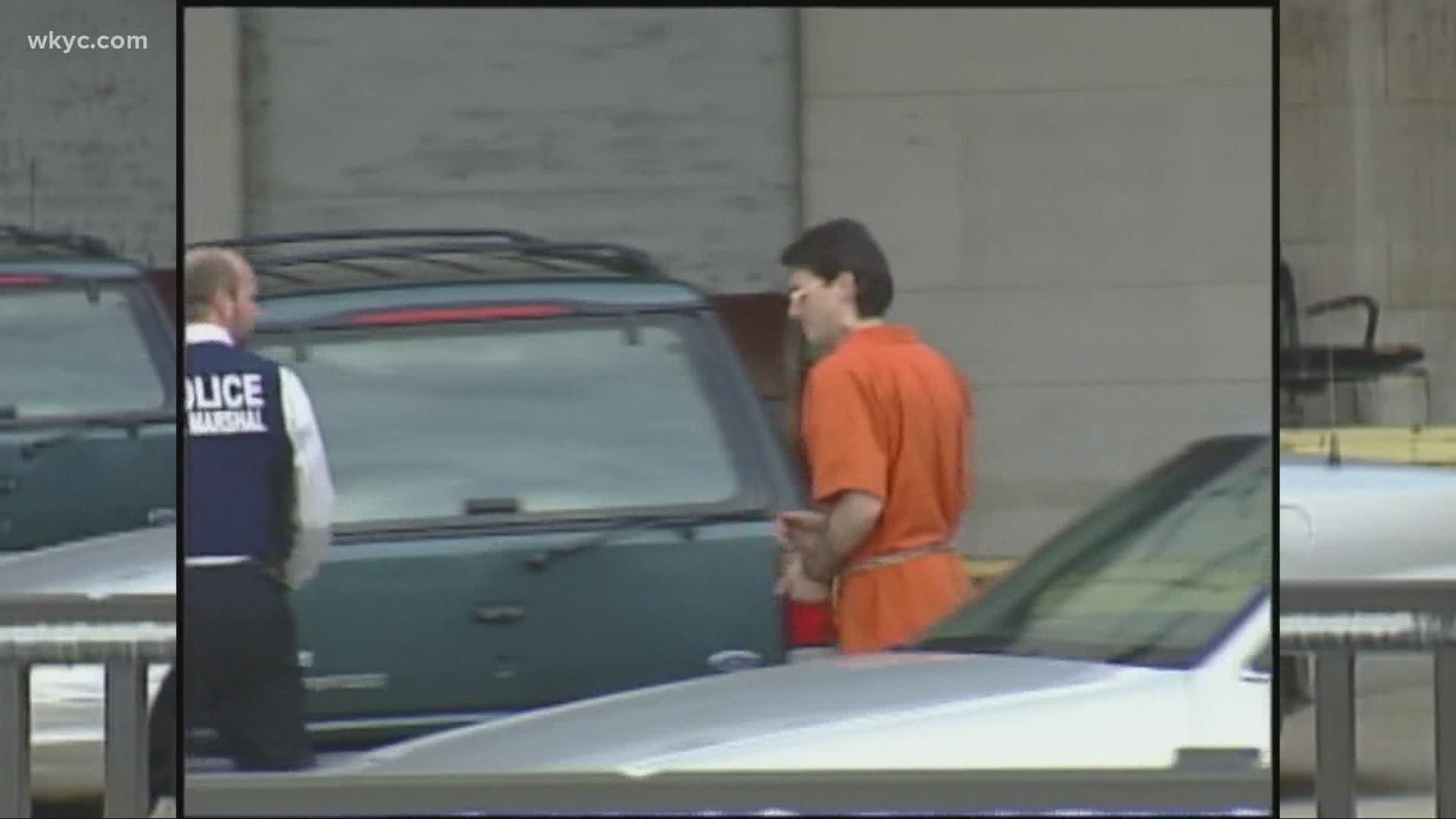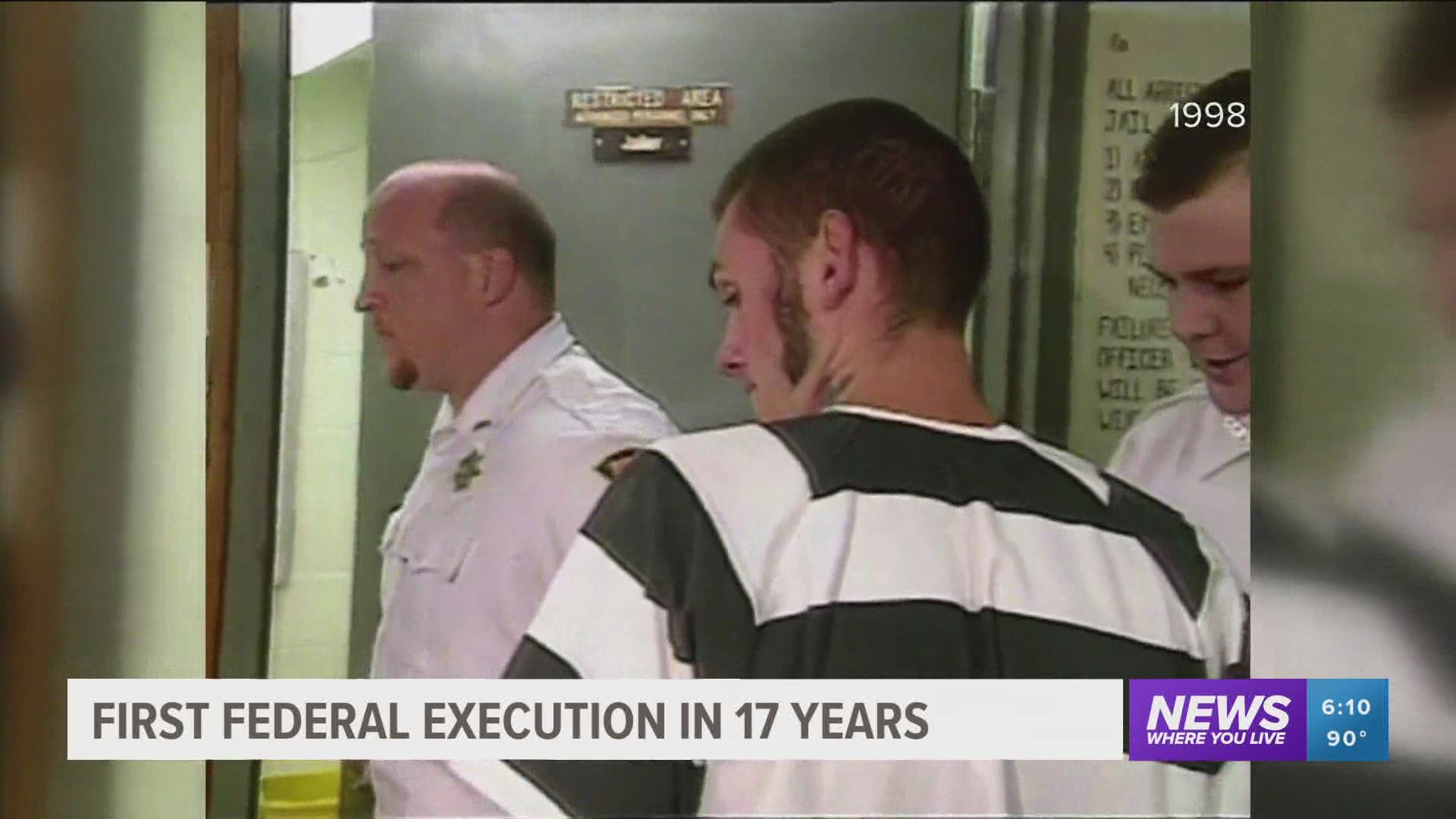TERRE HAUTE, Ind — Editor's Note: The video above is from July 14, 2020.
A Kansas girl’s killer Friday became the fifth federal inmate put to death this year, an execution that went forward only after a higher court tossed a ruling that would have required the government to get a prescription for the drug used to kill him.
Questions about whether the drug pentobarbital causes pain prior to death had been a focus of appeals for Keith Nelson, 45, the second inmate executed this week in the Trump administration’s resumption of federal executions this summer after a 17-year hiatus.
Nelson was pronounced dead inside the execution chamber at a federal prison in Terre Haute, Indiana, at 4:32 p.m. EDT, about nine minutes after the execution began.
When a prison official standing over him asked if he had any last words, Nelson didn't utter a word, grunt or even nod his head. After the official waited for about 15 seconds, his eyes fixed on Nelson waiting in vain for an answer, he turned away and began the execution procedure.
Nelson, whose face was entirely obscured behind a medical mask and a blue sheet across his body, stayed still as the lethal drug pentobarbital was delivered, which his attorneys made as the focus of their last-minute appeals. None of his limbs twitched or quivered, but after about a minute his chest and midsection began to heave and shutter involuntarily.
Nelson was convicted of grabbing 10-year-old Pamela Butler off the street and throwing her into his truck in broad daylight on Oct. 12, 1999, as part of a plan to find a female to kidnap, torture, rape and kill because he expected to go back to prison anyway.
The girl had been returning to her Kansas City, Kansas, home on inline skates after buying cookies. As he drove off with her, he made a rude gesture to her sister, who saw the attack and screamed. He later raped the fifth-grader and strangled her with a wire.
Nelson's attorneys said they had come to know him as someone other than a killer, that they “saw his humanity, his compassion, and his sense of humor.”
“The execution of Keith Nelson did not make the world a safer place," the lawyers, Dale Baich and Jen Moreno, said in a statement. “Keith’s death sentence was the result of a proceeding that denied him constitutionally guaranteed protections and reveals another deep flaw in the federal death penalty system.”
Cherri West, the mother of the young girl who Nelson killed, said his death had brought her some peace and hoped it would also bring peace to her daughter's soul.
Wearing a t-shirt emblazoned with her daughter Pamela's photo and angel wings emanating from behind it, West said she had no remorse for him and didn't expect he would show any for her family either. She recalled how Nelson had cursed at her and other family members during hearings in his case, adding that she thought he might curse at them again before being put to death,
“I wasn’t expecting him to say anything because he never had no remorse," she said.
Nelson’s spiritual adviser, Sister Barbara Battista, stood inside the death chamber as Nelson was executed. She spoke to him regularly since last month, most recently on Wednesday, saying he sounded more subdued than usual but not frightened.
“His parting words were … ‘I don’t want to see you on Friday but I probably will,’” she said in an interview before the execution. “He would rather be alive after Friday. But he is facing the reality.”
A flurry of filings by Nelson's legal team over several weeks zeroed in on pentobarbital, which depresses the central nervous system and, in high doses, eventually stops the heart.
In one filing in early August, Nelson's attorneys cited an unofficial autopsy on one inmate executed last month, William Purkey, saying it indicated evidence of pulmonary edema in which the lungs fill with fluid and causes a painful sensation akin to drowning.
In her now-overturned ruling, U.S. District Judge Tanya Chutkan halted Nelson's execution early Thursday, saying laws regulating drugs require the prescriptions, even for executions.
Within hours a panel at the U.S. Court of Appeals for the District of Columbia Circuit threw out Chutkan's order with little explanation.
Nelson’s crime was horrific by any measure.
Butler, a fifth-grade student, had been returning to her Kansas City, Kansas, home on inline skates after buying cookies at a store. As he drove off, Nelson made a rude gesture to Butler’s sister, who saw the attack and screamed.
Nelson, who didn’t previously know Butler or her family, told a co-worker a month earlier he planned to find a female to kidnap, torture, rape and kill because he expected to go back to prison anyway on other charges, prosecutors said.
After raping Butler, Nelson strangled her with a wire, then dumped her body in a wooded area near a Missouri church.
In a 2018 ruling, the 8th U.S. Circuit Court of Appeals said Nelson showed no remorse during a sentencing hearing statement and instead “blistered the district court and the victim’s family with a profanity laden tirade.”
With the execution Wednesday of Lezmond Mitchell — the only Native American on federal death row — the federal government under President Donald Trump registered more executions in 2020 than it had in the previous 56 years combined.
The executions of Nelson and Mitchell were carried out the same week as the Republican National Convention, where many Trump supporters sought to portray him as a law-and-order candidate.
Nelson’s current attorneys said Nelson's lawyers during the 2001 penalty phase of his case should have emphasized mitigating evidence, including that Nelson suffered brain damage as a newborn and was abused as a child. During arguments, prosecutors pointed to Nelson’s twin brother, saying he grew up in similarly difficult circumstances but had a good job and had done well.
The federal government has defended the use of pentobarbital, disputing that Purkey’s autopsy proved he suffered. They have also cited Supreme Court ruling precedent that an execution method isn't necessarily cruel and unusual just because it causes some pain.
___
Salter reported from St. Louis. AP reporters Mike Balsamo and Jessica Gresko also contributed to this report.


